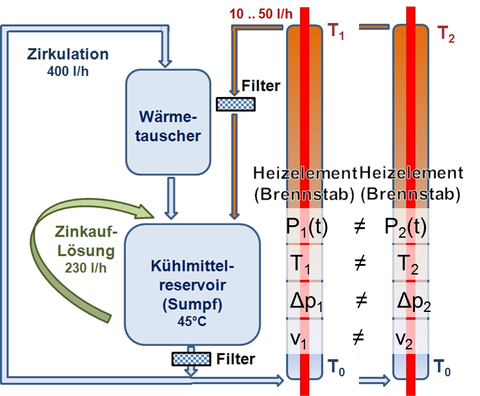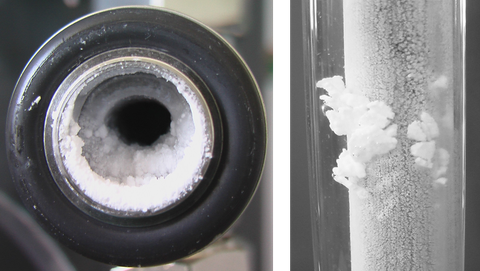Lokale Effekte im Druckwasserreaktorkern infolge von Zinkborat-Ablagerungen nach einem Kühlmittelverluststörfall
Hintergrund:
Im Falle einer Leckage im Primärkreislauf eines Druckwasserreaktors (sog. Kühlmittelverlust-Störfall KMV) gelangen große Mengen des borsäurehaltigen Kühlmittels in das Containment des Kernkraftwerks. Hierbei kann es bei den verschiedenen feuerverzinkten Einbauten zur Zinkkorrosion unter Bildung wasserlöslicher Zinkborate kommen. Beim Management eines solchen Störfalles käme es nach der Schnellabschaltung des Reaktors und dem Anlaufen verschiedener Notkühlsysteme nach einigen Stunden zum sogenannten Sumpfumwälzbetrieb, einer Situation, bei der diese wässrigen Lösungen im Containment zur weiteren Aufrechterhaltung der Kernkühlung wieder mit in den Primärkreislauf zurückgepumpt werden.
Da die Wasserlöslichkeit der gebildeten Zinkborate bei höheren Temperaturen abnimmt, besteht hierbei nun die Möglichkeit, dass diese dann an Heißstellen der Kernbereiche aus den Kühlmittellösungen ausfallen und sich unter Umständen schichtbildend dort ablagern könnten, was zu Beeinträchtigungen der weiteren Kernkühlung in dieser Spätphase eines KMV führen könnte.
Zielstellung:
Eine Hauptaufgabe des Vorhabens ist es, die Vorgänge, welche im Falle eines KMV (Druckwasserreaktor) hinsichtlich der Zinkkorrosion im Containment sowie der später möglichen Zinkboratabscheidung an Heißstellen im Kernbereich ablaufen, im kleinen Maßstab (PETrA-Laboranlage) unter störfallnahen Randbedingungen nachzubilden.
Dabei sollen besonders die hierbei stattfindenden chemischen und physikalischen Vorgänge im Einzelnen untersucht werden. Die hierbei erhaltenen Ergebnisse sollen dabei helfen, das Risikopotential einer solchen Beeinträchtigung der Kernkühlung in der Spätphase eines KMV besser einschätzen zu können und ggf. auch geeignete Strategien und Konzepte zu entwickeln, wie solche potentiellen Risiken zu vermeiden sind.
Analoge Versuche im größeren, halbtechnischen Maßstab mit den zugehörigen Untersuchungen und Auswertungen werden beim Projektpartner Hochschule Zittau-Görlitz durchgeführt.
Methoden und Ergebnisse:
Mit Hilfe einer zu diesem Zweck aufgebauten Laboranlage (PETrA) werden die chemischen und physikalischen Vorgänge, welche sich im Falle eines solchen KMV abspielen, unter störfallnahen Bedingungen (Temperaturverläufe, Druckverläufe, Korrosionsvorgänge mit auftretenden Veränderungen der Kühlmittelchemie etc.) simuliert und untersucht. Dabei kommen neben laborchemischen Untersuchungen und physikalisch-chemischen Untersuchungen auch verschiedene automatisierte Mess- und Regelsysteme zum Einsatz; z. B. Leitfähigkeits-Messsonden, Temperatur-Mess- und Regelsysteme oder Durchflussregler.
Inzwischen konnten einige generische Untersuchungen bezüglich der zu erwartenden Zinkkorrosion in borsäurehaltigen Kühlmittellösungen abgeschlossen werden. Es wurden u. a. verschiedene Einflussfaktoren (Temperatur, Strömungsverhältnisse, Kühlmittelchemie) auf die Geschwindigkeit der Zinkkorrosion und der daraus resultierenden Veränderungen der Kühlmittelchemie während eines solchen angenommenen Störfallablaufes ermittelt.
Die Gesellschaft für Reaktorsicherheit (GRS) führte zudem computergestützte Simulationsrechnungen solcher möglicher Störfallabläufe aus. Die Auswertung der dabei erhaltenen Daten lieferte wichtige Informationen bezüglich der anzunehmenden Temperaturverläufe, Strömungsverhältnisse und Druckverläufe in den verschiedenen Bereichen eines Druckwasserreaktors (Sumpf, Kernbereiche) für verschiedene zu untersuchende KMV-Szenarien.
Bezüglich der begonnenen Untersuchungen mit der Laboranlage in Hinblick auf die Simulation von Zinkboratabscheidungen an Heißstellen in Kernbereichen liegen noch abschließende Ergebnisse vor.

Schema zur Aufbau der PETRA-Laboranlage, mit der die Zinkfreisetzung im Sumpf und die nachfolgende Abscheidung der Korrosionsprodukte (Zinkborate) an Heißstellen im Kern simuliert werden.

Schichtbildende Korrosionsprodukt-Abscheidungen (Zinkborate) innerhalb von Hüllrohren im Heißkanal bei einer Aufheizung bis 90° C.
Publikationen:
H. Kryk, U. Harm, U. Hampel
Reducing in-core zinc borate precipitation after LOCA in pressurized water reactors
47th Annual Meeting on Nuclear Technology, 10.-12.05.2016, Hamburg, Germany
H. Kryk, U. Harm, U. Hampel
Corrosion of hot-dip galvanized containment installations - A potential cause for thermal-hydraulic effects after LOCA in PWR?
ICONE 24 - International Conference on Nuclear Engineering, 26.-30.06.2016, Charlotte, USA
A. Seeliger, S. Alt, W. Kästner, S. Renger, H. Kryk, U. Harm
Zinc corrosion after loss-of-coolant accidents in pressurized water reactors - Thermo- and Fluid-dynamic effects
Nucl. Eng. Des. 305 (2016), 489-502
